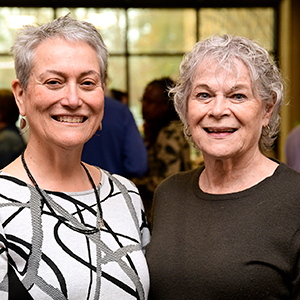When NIEHS grantee Lida Chatzi, M.D., Ph.D., ran a clinic for childhood obesity in Crete, Greece, more than a decade ago, she was struck by the daunting complexity of metabolic diseases.
 Chatzi, a physician-environmental epidemiologist, is deputy director of the NIEHS-funded Southern California Environmental Health Sciences Center at USC. Also, she is the lead researcher for the Rhea Mother-Child Study in Greece, and she has had significant leadership roles in major cohort studies investigating environmental exposures early in life. (Photo courtesy of Andrew Zaw / USC)
Chatzi, a physician-environmental epidemiologist, is deputy director of the NIEHS-funded Southern California Environmental Health Sciences Center at USC. Also, she is the lead researcher for the Rhea Mother-Child Study in Greece, and she has had significant leadership roles in major cohort studies investigating environmental exposures early in life. (Photo courtesy of Andrew Zaw / USC)“It has been clear to me since the beginning of my career that you cannot simply adhere to a specific diet or run 30 minutes a day and resolve the issue of obesity,” she said. “It’s more complex than that.”
Today, Chatzi has built a research program around understanding how exposure to environmental chemicals affects metabolic diseases such as obesity, diabetes, nonalcoholic fatty liver disease, and cancer. She is professor of Population and Public Health Sciences at the University of Southern California (USC), and she directs the school’s Center for Translational Research on Environmental Health.
Chatzi recently led an international research team to identify metabolic “signatures” that can determine the quality of diets in children and predict their metabolic health. The study, published in the journal eLife, is one of many projects integrating human population data and novel laboratory methods to yield important insights into exposure risk and disease development.
Health in crisis
According to Chatzi, the health of Americans has been declining for decades. This decline has been linked to the soaring incidence of chronic illnesses such as obesity and heart disease in certain regions of the U.S.
“The epidemic of many of these metabolic diseases follows the same geographical pattern,” she said. “Genetics can’t explain this type of trend, so we need to focus on the environment.”
Her research focuses on a relatively new scientific concept called the exposome, which aims to capture not only a single environmental exposure but the totality of exposures a person experiences throughout his or her lifetime. Chatzi’s lab uses advanced ‘omics technologies — such as exposomics, proteomics, and metabolomics — to investigate how the environment shapes human health.
Early-life exposures
For example, Chatzi and her colleagues showed that exposure in the womb to a mixture of so-called forever chemicals known as PFAS, or per- and polyfluoralkyl substances, may increase the risk of liver injury in children. They found similar effects after prenatal exposure to high levels of mercury.
Interestingly, her team discovered that children whose mothers ate the recommended one to three servings a week of fish — which are often contaminated with mercury but are also a source of important nutrients — had better metabolic health than those whose mothers rarely ate fish.
A natural experiment
More recently, Chatzi has begun exploring the use of bariatric surgery as a “natural experiment” to study the metabolic effects of environmental exposures. She has found that some participants in the Teen-LABS (Longitudinal Assessment of Bariatric Surgery) study lose weight after surgery and keep it off, whereas others gain weight back quickly. The difference in outcomes cannot be easily explained by diet or physical activity.
“Our hypothesis is that environmental pollution, the chemicals that are stored in body fat, could explain some of the variability,” said Chatzi. Her latest grant from NIEHS will enable her to test this hypothesis.
Nutrition’s influence
Another hypothesis Chatzi is investigating is whether diet could be an important factor to offset the impact of the environment on metabolic diseases.
For example, some studies have shown that the effect of air pollution on cardiovascular disease can be buffered by a Mediterranean diet, which is rich in antioxidants.
Human-relevant exposomics
Last October, Chatzi announced the launch of the USC Center for Translational Research on Environmental Health, which she leads (learn more in this Environmental Factor article.)
She noted that the center aims to expand knowledge about how the exposome influences metabolic diseases.
Chatzi added that through innovative study designs and interdisciplinary approaches, scientists will boost understanding of how a variety of environmental exposures can affect our biology.
“Our goal is to encourage the translation of basic biomedical and environmental health research into concrete strategies that protect and improve human health,” she said.
Citations:
Stratakis N, Siskos AP, Papadopoulou E, Nguyen AN, Zhao Y, Margetaki K, Lau CE, Coen M, Maitre L, Fernandez-Barres S, Agier L, Andrusaityte S, Basagana X, Brantsaeter AL, Casas M, Fossati S, Grazuleviciene R, Heude B, McEachan RRC, Meltzer HM, Millett C, Rauber F, Robinson O, Roumeliotaki T, Borras E, Sabido E, Urquiza J, Vafeiadi M, Vineis P, Voortman T, Wright J, Conti DV, Vrijheid M, Keun HC, Chatzi L. 2022. Urinary metabolic biomarkers of diet quality in European children are associated with metabolic health. eLife; doi:10.7554/eLife.71332 [Online 25 January 2022].
Stratakis N, Golden-Mason L, Margetaki K, Zhao Y, Valvi D, Garcia E, Maitre L, Andrusaityte S, Basagana X, Borras E, Bustamante M, Casas M, Fossati S, Grazuleviciene R, Haug LS, Heude B, McEachan RRC, Meltzer HM, Papadopoulou E, Roumeliotaki T, Robinson O, Sabido E, Urquiza J, Vafeiadi M, Varo N, Wright J, Vos MB, Hu H, Vrijheid M, Berhane KT, Conti DV, McConnell R, Rosen HR, Chatzi L. 2021. In utero exposure to mercury is associated with increased susceptibility to liver injury and inflammation in childhood. Hepatology 74(3):1546–1559.
Stratakis N, Conti DV, Borras E, Sabido E, Roumeliotaki T, Papadopoulou E, Agier L, Basagana X, Bustamante M, Casas M, Farzan SF, Fossati S, Gonzalez JR, Grazuleviciene R, Heude B, Maitre L, McEachan RRC, Theologidis I, Urquiza J, Vafeiadi M, West J, Wright J, McConnell R, Brantsaeter A, Meltzer HM, Vrijheid M, Chatzi L. 2020. Association of fish consumption and mercury exposure during pregnancy with metabolic health and inflammatory biomarkers in children. JAMA Netw Open 3(3):e201007.
Stratakis N, Conti DV, Jin R, Margetaki K, Valvi D, Siskos AP, Maitre L, Garcia E, Varo N, Zhao Y, Roumeliotaki T, Vafeiadi M, Urquiza J, Fernandez-Barres S, Heude B, Basagana X, Casas M, Fossati S, Grazuleviciene R, Andrusaityte S, Uppal K, McEachan RRC, Papadopoulou E, Robinson O, Haug LS, Wright J, Vos MB, Keun HC, Vrijheid M, Berhane KT, McConnell R, Chatzi L. 2020. Prenatal exposure to perfluoroalkyl substances associated with increased susceptibility to liver injury in children. Hepatology 72(5):1758–1770.
(Marla Broadfoot, Ph.D., is a contract writer for the NIEHS Office of Communications and Public Liaison.)








